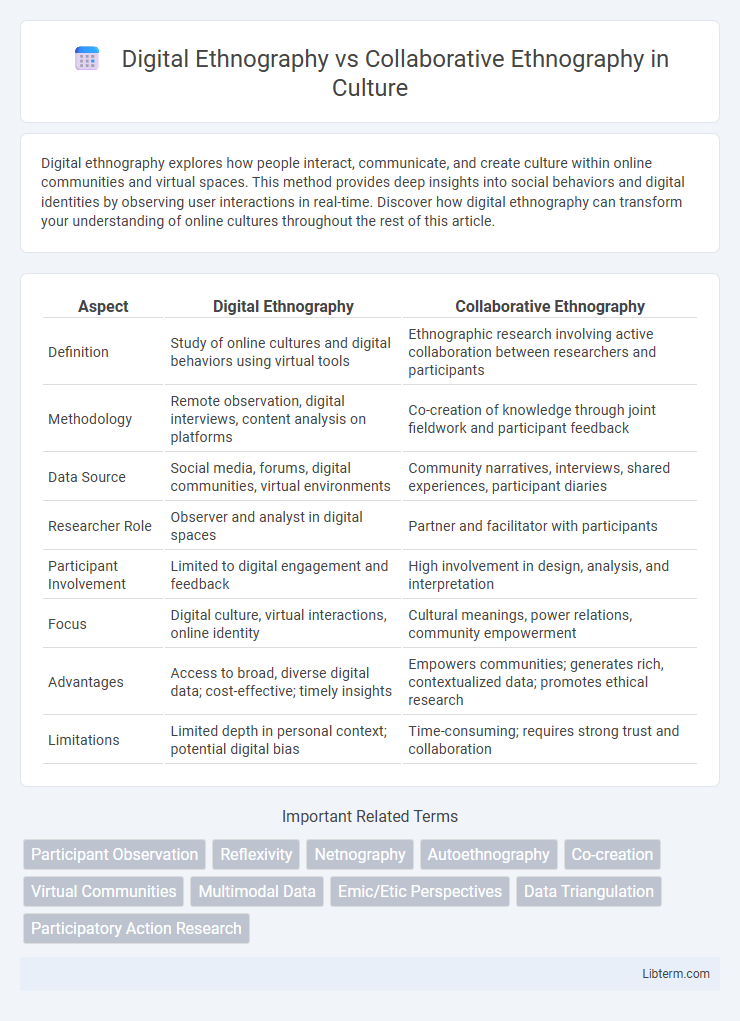Digital ethnography explores how people interact, communicate, and create culture within online communities and virtual spaces. This method provides deep insights into social behaviors and digital identities by observing user interactions in real-time. Discover how digital ethnography can transform your understanding of online cultures throughout the rest of this article.
Table of Comparison
| Aspect | Digital Ethnography | Collaborative Ethnography |
|---|---|---|
| Definition | Study of online cultures and digital behaviors using virtual tools | Ethnographic research involving active collaboration between researchers and participants |
| Methodology | Remote observation, digital interviews, content analysis on platforms | Co-creation of knowledge through joint fieldwork and participant feedback |
| Data Source | Social media, forums, digital communities, virtual environments | Community narratives, interviews, shared experiences, participant diaries |
| Researcher Role | Observer and analyst in digital spaces | Partner and facilitator with participants |
| Participant Involvement | Limited to digital engagement and feedback | High involvement in design, analysis, and interpretation |
| Focus | Digital culture, virtual interactions, online identity | Cultural meanings, power relations, community empowerment |
| Advantages | Access to broad, diverse digital data; cost-effective; timely insights | Empowers communities; generates rich, contextualized data; promotes ethical research |
| Limitations | Limited depth in personal context; potential digital bias | Time-consuming; requires strong trust and collaboration |
Introduction to Ethnographic Methods
Digital ethnography involves studying online communities and digital interactions, leveraging virtual tools to gather qualitative data, whereas collaborative ethnography emphasizes participatory research methods that engage participants as co-researchers in the study process. Both approaches prioritize immersive observation and contextual understanding but differ in their focus on digital environments versus collective involvement. Ethnographic methods include participant observation, in-depth interviews, and contextual analysis to capture cultural practices and social dynamics.
Defining Digital Ethnography
Digital Ethnography involves the study of online cultures, behaviors, and interactions through immersive, virtual methods, emphasizing data collection from digital platforms such as social media, forums, and virtual communities. It leverages tools like ethnographic software, digital interviews, and content analysis to explore how people communicate and construct identities in digital spaces. This method contrasts with Collaborative Ethnography, which centers on engaging participants as co-researchers in the study process to ensure shared ownership and mutual benefit of ethnographic findings.
Understanding Collaborative Ethnography
Collaborative ethnography emphasizes active participation and shared authority between researchers and community members, fostering deeper cultural insights and mutual understanding. It contrasts with digital ethnography's primarily virtual data collection by integrating face-to-face interactions and co-interpretation of findings. This approach enhances research validity and ethical engagement through collective knowledge production in diverse social contexts.
Historical Evolution of Ethnographic Approaches
Digital ethnography emerged as a response to the increasing integration of technology and online communities, evolving from traditional ethnographic methods developed in the early 20th century. Collaborative ethnography, rooted in participatory research of the 1970s and 1980s, emphasizes co-creation of knowledge between researchers and participants, reflecting shifts towards more inclusive and ethical research practices. Both approaches illustrate the historical trajectory from observer-centered studies to interactive and technology-mediated ethnographic inquiry.
Methodological Differences: Digital vs Collaborative
Digital ethnography employs online platforms and digital tools to observe and analyze virtual communities, emphasizing remote data collection and interaction through social media, forums, and digital communication. Collaborative ethnography involves active participation and co-creation of knowledge with community members, prioritizing shared authority and reflexivity in fieldwork. Methodologically, digital ethnography relies on digital trace data and virtual immersion, whereas collaborative ethnography centers on relational engagement and iterative dialogue within the research process.
Data Collection Techniques and Tools
Digital Ethnography employs online platforms, social media analytics, virtual interviews, and digital content analysis tools to collect data from virtual communities and online interactions, emphasizing real-time digital behavior patterns. Collaborative Ethnography involves participatory data collection methods such as co-created field notes, group interviews, and participant-led commentary, often using audio recordings and shared digital workspaces to engage community members actively. Both approaches utilize technological tools but differ in data collection focus: Digital Ethnography prioritizes virtual data sources, while Collaborative Ethnography emphasizes collective knowledge production through direct participant involvement.
Participant Engagement and Ethical Considerations
Digital ethnography leverages online platforms to engage participants through virtual interactions, enabling researchers to observe naturally occurring behaviors in digital spaces while ensuring privacy and informed consent via secure channels. Collaborative ethnography emphasizes direct partnership with participants in data collection and analysis, fostering mutual trust and co-ownership of findings that enhance ethical transparency and empower community voices. Both methodologies require rigorous ethical frameworks tailored to their contexts, balancing participant autonomy, confidentiality, and the authenticity of cultural representation.
Challenges and Limitations of Each Approach
Digital ethnography faces challenges such as limited access to non-verbal cues, difficulties in building rapport, and potential biases from online platform algorithms affecting data authenticity. Collaborative ethnography encounters limitations like coordinating diverse participant input, balancing power dynamics between researchers and community members, and ensuring ethical considerations in shared authorship. Both approaches require careful methodological adaptations to maintain validity and ethical integrity in capturing cultural insights.
Case Studies: Digital vs Collaborative Ethnography
Case studies in digital ethnography reveal immersive online environments where researchers analyze virtual interactions and social media behaviors using tools like data mining and real-time observation. Collaborative ethnography case studies emphasize community partnership, co-creation of knowledge, and shared interpretation of cultural practices through collective interviews and participatory methods. Comparing both, digital ethnography excels in accessing dispersed digital communities, while collaborative ethnography provides deeper contextual understanding rooted in mutual trust and local expertise.
Future Directions in Ethnographic Research
Future directions in ethnographic research emphasize integrating Digital Ethnography's ability to analyze vast online data with Collaborative Ethnography's participatory methods to enhance contextual understanding and cultural sensitivity. Advances in AI and machine learning enable more sophisticated analysis of digital interactions, while collaborative frameworks prioritize ethical co-creation and community empowerment. Combining these approaches fosters richer, multi-dimensional insights and promotes innovative methodologies for studying evolving digital and social landscapes.
Digital Ethnography Infographic

 libterm.com
libterm.com